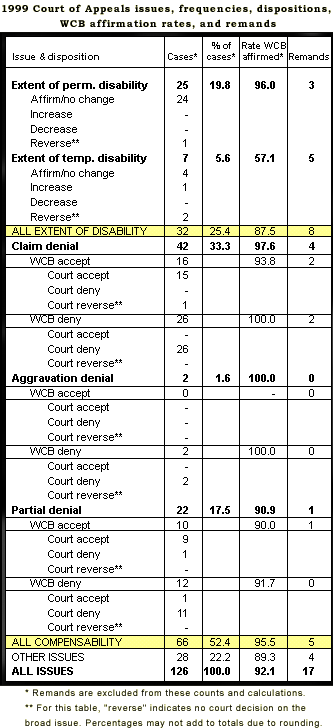
In 1999 there were 219 appeals of Workers’ Compensation Board (WCB) decisions to the Oregon Court of Appeals. See Figure 1. This number represents a decrease of 12.7 percent from the previous year. The number of appealable board orders (orders on review) dropped by about 18.9 percent for this period, so the appeal rate rose slightly to 21.9 percent. The petitioner was the claimant in 58.0 percent of the cases, up from the 56.8 percent of 1998 but lower than the 1994-1997 average of 61.0 percent.

There were 126 court decisions in 1999 (based on the date of the slip opinion), 3.1 percent fewer than in 1998. This count excludes court dismissals and two orders on reconsideration by the court. The count also excludes 17 court remands to the board, where the court did not (1) rule on the primary issue, (2) direct a specific action by the board, (3) rule on a major or precedent-setting sub-issue, nor (4) determine that the board applied the wrong standard. The most frequent reasons for remanding: the board did not have benefit of a recent court decision (seven cases), the board did not fully address or resolve an issue (four cases), and the board order was inadequate for review (three cases).
Order counts here also exclude six safety cases and seven Department of Consumer and Business Services (DCBS) contested cases. Contested cases are discussed briefly in the final section of this report.
Issues
The number and the relative frequency of each issue are given
in the table. Cases without one of the  specified
issues are counted in the “other issues” category.
The relative frequency of extent of disability was the highest
since 1991, while that for compensability was the lowest since
1994 and well below 1997’s record-high 59.4 percent. Only
two cases dealt with the aggravation issue. The percentage of
cases classified as “other issue” was the lowest
on record. The most frequent other issues (including those
in cases with a specified issue) were insurer penalty (15 cases);
responsibility (11 cases); claimant attorney fees (nine cases);
claim bar, issue preclusion, or res judicata (seven cases);
claim classification and jurisdiction (four cases each); and
attorney sanctions and evidence (three cases each).
specified
issues are counted in the “other issues” category.
The relative frequency of extent of disability was the highest
since 1991, while that for compensability was the lowest since
1994 and well below 1997’s record-high 59.4 percent. Only
two cases dealt with the aggravation issue. The percentage of
cases classified as “other issue” was the lowest
on record. The most frequent other issues (including those
in cases with a specified issue) were insurer penalty (15 cases);
responsibility (11 cases); claimant attorney fees (nine cases);
claim bar, issue preclusion, or res judicata (seven cases);
claim classification and jurisdiction (four cases each); and
attorney sanctions and evidence (three cases each).
Court dispositions and WCB affirmation rates are given in the table. The court reversed the board in one permanent disability case, three temporary disability cases, and three other-issue cases. (These counts exclude remands; remand counts for each issue are also given in the table.) The WCB affirmation rates were 95.5 percent for the compensability issues and 92.1 percent overall (see Figure 2).
The WCB acceptance rate for the three compensability issues was 39.4 percent, and that for the court was 37.9 percent. Last year, both figures were 44 percent.

SAIF was the insurer in 33.6 percent of the cases. There were three cases about permanent total disability (PTD was awarded at some level). In two of these cases, the court affirmed a board decision that rescinded or affirmed the rescission of a PTD award. In the other case, the court affirmed a board order affirming a PTD grant. The median time lag from appeal to court order was 343 days (11.3 months), somewhat longer than 1998’s 330 days. The median time from injury to order was 1,446 days (4.0 years).
Seven contested cases (disputes heard by a Workers’ Compensation Division administrative law judge) were decided by the court in 1999 (based on the date of the slip opinion). This count excludes settlements. Dispute types were medical treatment (three cases), vocational assistance (two cases), managed care treatment, and miscellaneous. (The issue in the “miscellaneous” case was whether the worker may continue treatment by the original doctor after a managed care contract began.) The worker was the petitioner in three cases. The court affirmed the director in all seven cases, so the worker prevailed in four cases (57.1 percent).
If you have questions about the information contained in this document please contact by e-mail or phone: Russell Reed, Research Analyst, Research & Analysis Section, Information Management Division (503) 947-7343.
This document was originally published in
May 2000.
[Printed form: 440-2340(05/00/IMD)]
In compliance with the Americans with Disabilities Act (ADA), this publication is available in alternative formats by calling (503) 378-4100 (V/TTY).